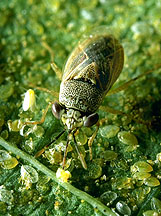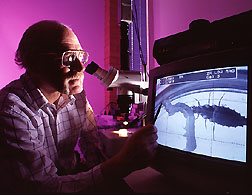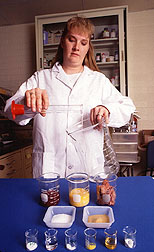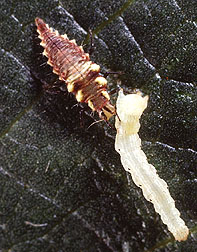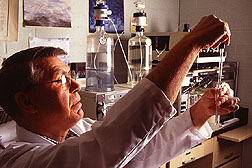Mass-Reared Insects Get Fast Food
|
|
It's now possible to economically raise hundreds of thousand—even million—of insects to release in fields where they will devour damaging crop pests. The research finding that made this a reality is a recipe for an artificial diet that insects not only survive on, but actually thrive on.
This major breakthrough has the potential to greatly expand the use of biological control agents in agriculture while reducing dependence on chemical products.
"If we could give our predatory insects a blindfold test, they wouldn't be able to tell the difference between their normal food and the artificial diet we developed," says Allen C. Cohen, an Agricultural Research Service entomologist who recently applied for a patent for his invention.
With this diet, scientists can now mass-rear big-eyed bugs, Geocoris punctipes, and lacewings, Chrysoperla carnea. Both are voracious insects that devour a wide range of plant-destroying insects. Their menus include the sweet potato and other whiteflies, aphids, scale insects, moth eggs and larvae, and mealybugs.
"The largest uses of this diet and the predaceous insects it feeds might be against the silverleaf whitefly, also known as strain B of the sweetpotato whitefly," says ARS entomologist Thomas J. Henneberry. He is director of the agency's Western Cotton Research Laboratory in Phoenix, Arizona. "This insect is distributed worldwide and is a billion-dollar pest of cotton and vegetables, with more than 300 host plants."
"Crops in Arizona, California, Texas, and Florida have been especially hard hit by the tiny, sap-sucking insect since its discovery in this country in 1986," Henneberry says. "From 1991 to 1994, for example, the whiteflies—Bemisia argentifolii—have been blamed for close to $1 billion in farm and related economic losses in southern California's Imperial Valley."
| "Diet Critical to Mass-Rearing Beneficials" by Ray Carruthers ARS National Program Leader for Biological Control |
Beneficial predators have been used for decades for insect control. However, their widespread use has been hampered by inadequate methods to rear them on artificial diets or by the cost of rearing prey for them to feed on.
For example, a lacewing that is mass-marketed requires a diet of insect eggs that costs more than $300 per pound to produce. The new diet can be made for about $2.50 per pound. And each pound of the new diet can produce about 30,000 big-eyed bug adults or up to 10,000 lacewing adults that will yield about 3 million eggs during their lifespan.
One of the more interesting facts revealed in the patent application is that the diet consists of food ingredients anyone can get at the grocery—ground beef and beef liver. Besides beef, the diet can be made from fish innards, oysters, or meat and liver from other animals—whatever is cheapest.
"We expected the insects to go for what we would call a junk-food diet because they need cholesterol and cannot manufacture it themselves," says Cohen. "Our new diet has enough cholesterol to sink a battleship, or to give the whole crew heart disease. A key feature of this new line of insect diets, since they are presented in a solid or semisolid form, is that we can pack them with the high cholesterol and fat contents that are relished by predatory insects."
But the key was getting the diet to mimic the actual texture of natural prey. That turned out to be another item from the supermarket—eggs. Cooked hens' eggs provide stickiness to hold or retain the medium's components and nutrients and help prevent their separation. The egg whites also provide extra proteins, while the yolks are an excellent source of cholesterol, lipids, lipoproteins, protein, and B-vitamins.
With slight modification, the diet works for other beneficial predatory arthropods.
The hallmark of this diet and its reason for success are that it is based on the predators' feeding biology and nutritional chemistry—processes that were misunderstood for decades.
Before Cohen's studies, entomologists and insect nutritionists thought that the predators and parasitic insects known as entomophages drank only the body fluids of their prey. Cohen's work shows that these entomophages actually absorb the concentrated solid materials inside their prey. This discovery led to the entirely new approach to predator and parasite dietetics.
Each diet parallels the composition of nutrients in the biocontrol insect's natural prey. The ARS scientists determined this by dissecting the prey by protein hydrolysis and subsequent amino acid analysis, gas-liquid or liquid chromatography of lipids, microbial bioassay of vitamins, atomic absorption spectrophotometry for minerals, and overall bioassay.
The key to developing the new diets was obtaining a thorough understanding about how these and most other predatory arthropods actually eat their natural prey. It seems they digest their target prey outside their bodies. This process, now gaining wide recognition in the scientific community, is called extra-oral digestion.
For example, a big-eyed bug punctures another insect with a sharp, stingerlike structure that comes out of its mouth. Then it squirts a digestive enzyme that dissolves or breaks down the prey's insides. The big-eyed bug can then use the hollow stinger as a straw to suck up its meal.
This is not unique among such insects; about 80 percent of all predatory insects and their relatives eat this way, including spiders, mites, scorpions, and centipedes.
"This extra-oral-digestion feeding mechanism allows lacewing larvae, big-eyed bugs, and other predators to feed on much larger insects than biocontrol users previously expected. All they have to do is anchor themselves and begin eating," says Cohen.
"And eat they do—up to 25 to 50 percent of their own body weight in prey each day. They strongly prefer to eat larger prey over smaller ones. Expecting a lacewing larva or big-eyed bug to sustain itself by eating only the smallest whiteflies or aphids exclusively is like expecting a 250-pound football player to thrive on sesame seeds eaten one at a time.
"Given a choice between large and small prey, big-eyed bugs and most other arthropods that use extra-oral digestion eat the largest ones first," says Cohen. "This appears to be a mechanism to get the large amount of nourishment they need to survive. But the observation is contrary to what some entomologists had previously thought," he says.
"Such feeding behavior could explain why some proven predators didn't work out in fields. They may have eaten the target insect in laboratory tests, but when released in actual fields, they went after larger insects and not the problem insect we'd targeted for them.
"One of the surprises that came from this research is seeing how efficiently these predators can extract nutrients from their prey's body," Cohen says. "At first, biocontrol experts understood this efficiency as a disappointment, because it meant that more predators would be needed to kill the numbers of insects that growers wanted to eliminate. These predators do not engage in wasteful killing as was once postulated.
|
|
"But when we have a realistic picture of the true nature of the predation, we can make adjustments by using more predators. We have a good thing with them. In nature, they are considered to be keystone species that stabilize and regulate populations of plant-eating insects. By understanding their assets and liabilities and treating them realistically and with respect for their potential usefulness, we can get them to do the same kind of work in our agricultural fields as they do in nature," says Cohen.
Insects that eat the diets produce more offspring, often mature faster, and are up to 1½ times larger than those feeding in the wild. The larger size is not a sign of obesity or some unhealthy phenomenon.
"These predators coming off the diet are at fighting weight, ready to consume several times their weight in pest insects over a few days," says Cohen. "Insects don't seem to get obese the way mammals do."
Entomologists praise C. carnea highly as a generalist predator. It suppresses aphids, lepidopterans (both eggs and small larvae), and a variety of other slow or nonmoving, soft-bodied arthropods. It could make a good candidate for mass-rearing and release because it has good search qualities and high kill rates and has been proven not to attack other beneficial arthropods or crop plants. It is also one of the most voracious predators found in agricultural systems.
"It is a native species, as are several related species used for biological control," says Cohen. "This family of insects is known to feed exclusively on prey, so they can do no damage to crop plants. Since C. carneais well-known and respected by growers, its mass-production and distribution will not take a great deal of selling."
C. carnea is already being sold commercially to greenhouse growers and those with small plots of high-value cash crops, but it is too expensive for mass-release on major crops. Until Cohen's diet, no other artificial diet had proven cheap enough for mass-rearing these insects.
Cohen's diet yielded C. carneawith unexpected superior quality, compared to insects reared on previously known artificial diets or on its natural food source, Sitotroga eggs.
Cohen has so far reared 16 successive generations of C. carnea, 130 of G. punctipes, 3 of Serangium parcesetosum (a lady beetle), and 3 of Orius insidiosus (a minute pirate bug).
In contrast to previous teachings, Cohen discovered that he can include antimicrobial agents like potassium sorbate or streptomycin in the diet without harm to the insects being mass-reared. This prevents spoilage by bacteria and fungi and extends the shelf life of the artificial diet from about 1-½ days to 3 to 4. When insects are reared on these extended-life products, workers have to change the packages less frequently, and that can cut labor costs by about one-half.
"Large pet food processors might help us get the diet into production," says Cohen. "They already have the equipment needed to mass-produce the feed. They could easily add the insect diet product to their production line."
Cohen reports some interest on the pet food sector's part and considerable interest from the growing biological control product industry. Evidence of widespread interest is the financial support that was provided by the Imperial County Whitefly Committee for development of the new insect diet.
The patent application (No. 08/699,815) is titled "Artificial Media for Rearing Entomophages."
— By Dennis Senft, ARS.
Thomas J. Henneberry is at the USDA-ARS Western Cotton Research Laboratory, 4135 E. Broadway Rd., Phoenix, AZ 85040; phone (602) 437-0121 ext. 236.
<BR







